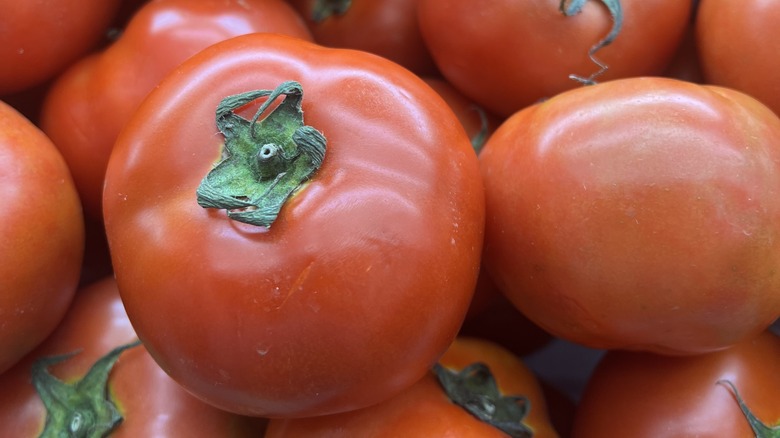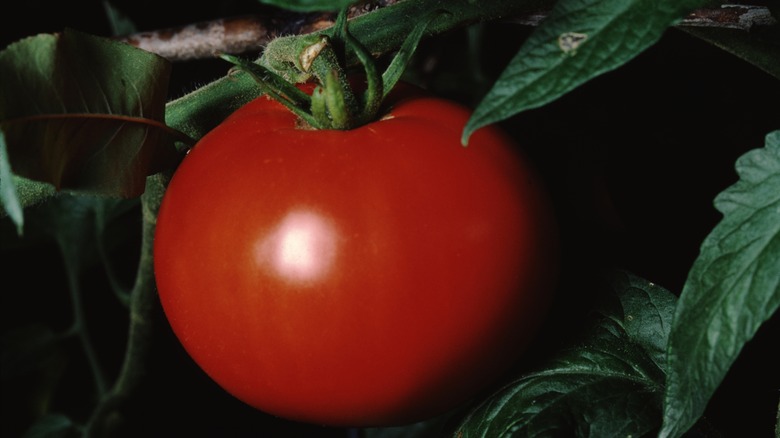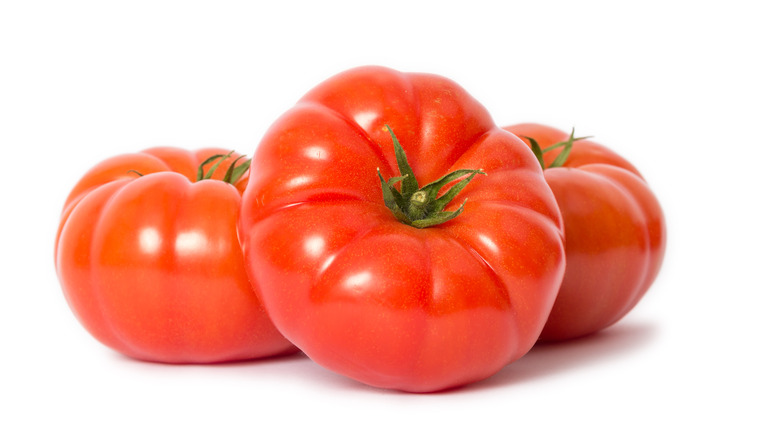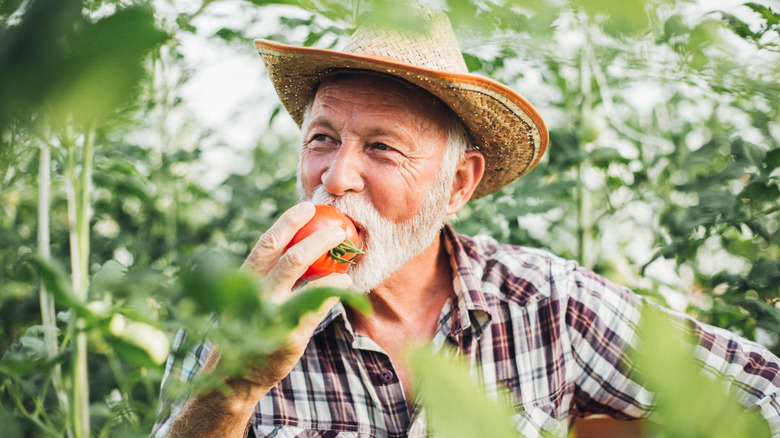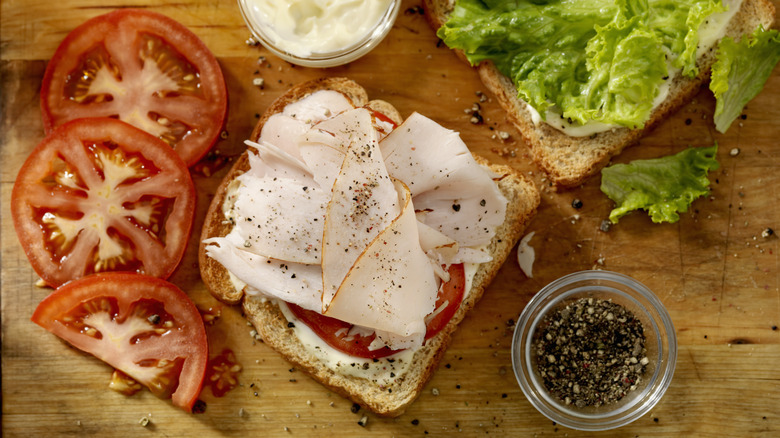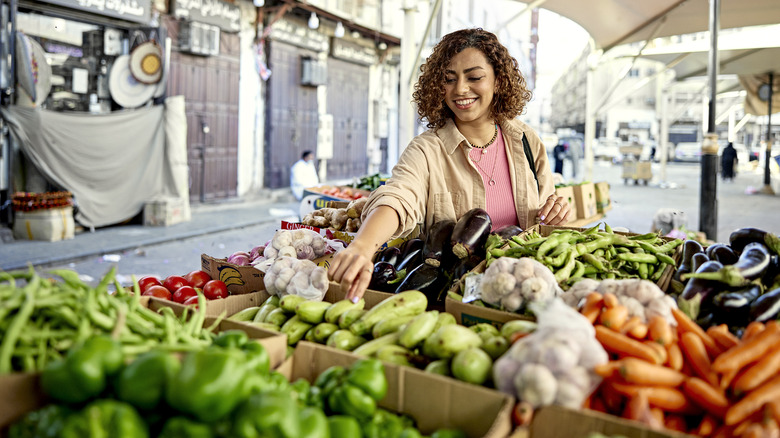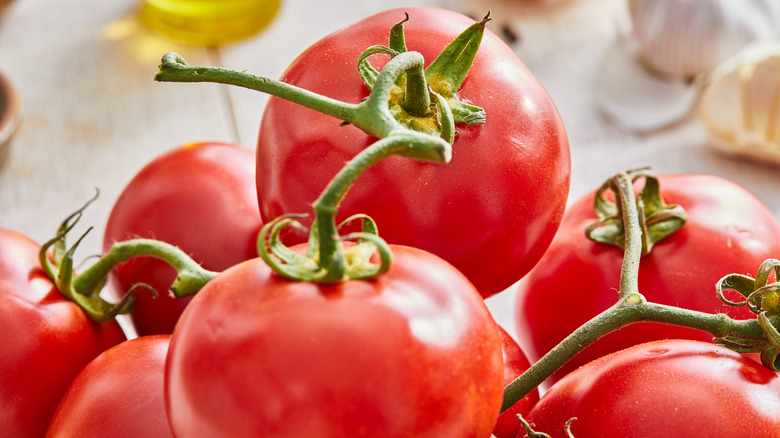What Are Better Boy Tomatoes And What Do They Taste Like?
You've heard of cherry, grape, beefsteak, and Roma tomatoes, but considering more than 10,000 varieties of these fruits exist, there's a good chance you don't know all the names of the most popular types you'll find in grocery stores. You may not think you're familiar with Better Boy tomatoes (and even less likely, their scientific name Solanum lycopersicum 'Better Boy'), yet you've probably used them in recipes from time to time. It's easy to mistake them for beefsteak tomatoes, since they're large, bright red, and juicy.
Better Boy tomatoes are versatile and famous fruits, as they hold a Guinness World Record for highest amount of tomatoes produced on a single plant (340 pounds). They work well crushed and blended up in sauces or sliced in fresh and cooked dishes, and they can hold their own during freezing or canning. Unlike Roma tomatoes, which are an open-pollinated type, Better Boys are hybrids, meaning they're the result of two cross-pollinating parent fruits.
What are Better Boy tomatoes?
The Better Boy tomato is a cross between two other cultivars: the Big Boy and the Teddy Jones. The resulting hybrid was intentionally created in 1964 by John Peto and Paul Thomas of the Petoseed Company. Prior to working there, Peto was employed by the W. Atlee Burpee Speed Company, from where he took the Teddy Jones seeds. It was Burpee that first bred the Big Boy variety in 1949 (along with carrot, cabbage, and pepper hybrids, among others), which is now a parent plant to some of the most popular homegrown tomatoes, Better Boys included. They were designed to be pretty similar to their parent fruits, but with more resistance to disease.
For this reason, along with their high fruit yield and flexibility to grow in different types of weather, the Better Boy variety is a home garden favorite. It's an indeterminate tomato variety, meaning it keeps growing and producing fruit throughout the entire season. And each individual tomato is about 1 pound in size and bright or dark red in color. As their scientific name suggests, they're part of the Solanaceae plant family and, therefore, close relatives of other nightshades like potatoes and eggplants.
Better Boy tomatoes vs. beefsteak tomatoes
Better Boy and beefsteak tomatoes do share some similarities, and at first glance, you might mistake these two fruits for each other. They're both indeterminate types, though beefsteaks can be hybrids or heirlooms, while Better Boys are hybrids only. Unlike hybrids, heirlooms are pollinated naturally (aka open-pollinated), just like the Roma tomatoes we mentioned earlier. Both Better Boys and beefsteaks are large, bright red, easy to grow in home gardens, and produce a lot of fruit on a single plant. They can be used in all the same types of recipes and have a very similar taste.
And yet, there are minor differences between these two. There's only one type of Better Boy tomato, for instance, while beefsteaks have about 350 varieties, including Big Beefs, Bucking Broncos, and Cherokee Purples. And while they're both large varieties, Better Boys may be slightly heftier on average with a softer texture. We know that Better Boys were bred to be disease-resistant, but beefsteaks are much less so, and they require a little more water than their peers to stay healthy on the vine.
What do Better Boy tomatoes taste like?
In short, Better Boy tomatoes taste how you'd expect tomatoes to taste. They have a balanced flavor that's not too acidic or too sweet, but that has both of these qualities in equal amounts. Their full, well-rounded taste makes them extremely versatile, as they're delicious both fresh and cooked, and they're one of the most popular tomato varieties for this reason. Better Boys have a smooth skin, a classic round tomato shape, and a meaty texture. As is common with large varieties of these fruits, they're full of juice.
If you want a sweeter tomato, you'll want to go for cherry or cocktail types instead of Better Boys. For a firmer texture with more of a bite, dabbling in plum, Roma, or grape tomatoes is the way to go. And for a unique color and overall appearance, you may want to try green, Gourmet Yellow Stuffer, or pear tomatoes. But for a big, juicy fruit with a typical tomato flavor, opt for a Better Boy.
How to cook with Better Boy tomatoes
As we've covered, Better Boy tomatoes excel in a wide variety of dishes. Since they're so large and full of flavor, they work well when sliced on sandwiches, paninis, and grilled cheeses. Specifically, they're the perfect "T" in a BLT, although they'd also be tasty additions to a grilled pesto mozzarella sandwich or a loaded sprouts and avocado sandwich. Their slices will fit perfectly over your bread in most cases, unlike smaller tomato varieties like cherry and grape. You may want to avoid placing them directly on the bread, though, since their juices can cause it to get soggy over time.
If you're a fan of Better Boys' fresh, classic tomato flavor, cut them up and add them to salads and grain bowls. But since they're so big and juicy, note that they make fantastic additions to recipes that capitalize on their liquids, like sauces, soups, and stews. Try roasting them to deepen their flavor even more before adding them to a roasted tomato sauce or roasted tomato soup, or use them in recipes for other veggie-based soups, pizza sauces, and casseroles. If you grow more Better Boys than you can use at once (a likely possibility considering their high yield), can or freeze them for preservation. Just keep in mind that you may want to reserve the frozen fruits for sauces and soups, since storing them this way will alter their consistency once thawed.
Where to buy Better Boy tomatoes
It helps that Better Boy tomatoes are so popular, because you can often find them wherever you normally get your produce. For instance, they may be in stock at your local Walmart. You can also try tracking them down at farmers markets from the summer until the beginning of winter. Because these tomatoes are an indeterminate type, they'll continue growing for longer than some other varieties. When choosing a Better Boy out of the bunch, look for one that is bright red and firm with just a little give when you squeeze it lightly.
These tomatoes were bred to be some of the best types to grow at home, and there is no shortage of online retailers that sell their plants. You can find them on Amazon and Etsy, or from a variety of smaller websites like Rohrer Seeds and Supplies. About 70 days after you plant the seeds, you should reap a ton of tomatoes, but keep the plants out of the reach of pets, as unripe fruit and some plant parts can be toxic to animals.
Nutritional information about Better Boy tomatoes
Tomatoes in general are highly nutritious vegetables, and Better Boys are no exception. These fruits are good sources of vitamin C, vitamin A (converted in our bodies from beta-carotene), vitamin K, fiber, potassium, and folate. They're also fat and cholesterol-free, and low in calories and sodium. Don't count on tomatoes to get your protein or carbs, but they do have trace amounts of these nutrients as well.
Where these fruits really shine is in their lycopene content, as one small tomato contains over 2,000 micrograms of the compound. Lycopene is an antioxidant that gives Better Boy tomatoes their red coloring, but it may also lower your risk of getting cancer or a cardiovascular disease. It's particularly concentrated in tomato skin, so don't peel them before eating to get the full effects, and know that cooking the fruits may also increase the amount of the antioxidant they hold. Aside from these benefits, tomatoes may help protect your skin from getting sunburns and lower your risk of heart attacks and strokes, according to Healthline. However, make sure you don't overdo it — eating too many tomatoes can lead to lycopene overdose (aka lycopenemia), which can cause stomach pain and kidney stones (via HealthifyMe).
How to store Better Boy tomatoes
Contrary to popular belief, Better Boy tomatoes should not be kept in the fridge. Why? The cold air will make them become firm instead of succulent, and their potent flavors will fade away. Instead, the best way to keep tomatoes fresh is to leave them on the counter or on a table, as their ideal storing temperature is around 60 degrees Fahrenheit. If it's hot where you live, or if it's just the middle of summer, try storing them inside a cool, dark cabinet instead. The same goes for when you buy produce a few days before it's ripe — keep everything on the counter or in a cabinet until it's ready to eat.
The exception is if you have a perfectly ripe tomato, but aren't able to eat it for a few days. In this case, storing it in the fridge can actually slow down further ripening, keeping the fruit edible for a little while longer. And if you've already cut yours into slices but can't use them all at once, make sure to keep any extras in the fridge. Just wrap them tightly in plastic wrap to prevent the juices from evaporating, and try to use them within a day or two.
